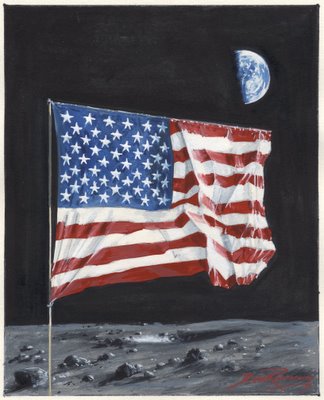A Flag on the Moon
The brilliant flash of red, white and blue against the extreme grays and blacks of the lunar surface is a wonderful contrast and has become a favorite subject of mine and in some cases a fairly poignant theme to different artists.
I have collected from various space artists their versions of a flag on the Moon. Most of the work was completed by the time I acquired it, but if the work was a commission all I asked of the artist was to be unique.
 The first flag painting added to the collection is a work done by Dr. William Hartmann and is entitled "We Were There." Dr. Hartmann worked as a planetary geologist during the Apollo Era. Bill was instrumental in developing some of the theories on Basin Impact Formation and the Origin of the Moon.
The first flag painting added to the collection is a work done by Dr. William Hartmann and is entitled "We Were There." Dr. Hartmann worked as a planetary geologist during the Apollo Era. Bill was instrumental in developing some of the theories on Basin Impact Formation and the Origin of the Moon.I asked Bill what prompted him to paint this piece. Bill's response surprised me and very much added to emotion of the work.
"I always have a wistful feeling about the fact that we went to the moon...I was a graduate student working on lunar research (when) JFK announced the goal and worked through to my PhD in lunar work and craters during that decade. The simple shutdown of the whole effort leaves me with feelings of lost youth."
Bill goes on to discuss the fact that Alan Bean had influenced this particular painting, but he still returned back to the subliminal reason for the painting.
"I wanted to play with the colors of the flag against the blue Earth, and the idea of this symbol of our audacity left there in this lonely place all these years, after everyone packed up and went home to that blue orb in the sky."
While Dr. Hartmann's work may reflect the disappointment at the ending of a great moment in exploration, there are other artists that look at the flag as an inspiration of what Man can accomplish.

One painting that looks towards the inspiration of Man on the Moon is "One Earth and Fifty Stars" by Detlev van Ravenswaay. While one of the unique things about Deltev has been his ability to explore Space in the abstract with his work, he follows the norm in this painting.
This study of the final work recreates his vision of the flag after the successful landing of Apollo 11 as inspiration for future missions to the Solar System.
"Apollo 11 - first manned landing on the Moon. Armstrong and Aldrin planted the US Flag in the Sea of tranquility - above the flag, the Earth, our home planet. This is my favorite painting (that) I ever did."
The painting uses two colorful objects (the flag and the Earth) as contrasting subjects against the gray of the lunar surface and the blackness of outer space. The flag as the main object reflects one nation's travels to another world, but the Earth reflects all Mankind's wonder at the journey.
Sometimes the inspiration comes from the need to create something different. Another wonderful artist from Europe is Ed Hengeveld of the Netherlands. Ed has produced some excellent work on the entire space program. Ed's work portrays through realism Man's flights in Space and landings on the Moon.
I commissioned Ed to paint a flag on the Moon for me. My only request was that it be different from the normal portrayal of the flag as it sits on the lunar surface. "Two Flags" was Ed's answer to my request.
The rare use of the flag patch on a moonwalker's A7L EVA suit is juxtapositioned against the lunar surface flag in the background in the composition. It is not the standard flag on the Moon portrait.
In a recent purchase, I was able to acquire another work by Chris Butler titled "Old Glories" The above piece shows the flag from a different perspective. As if lying flat on the ground we are looking up at the flag with an eye level view of the lunar bootprints. The setting sun and the eye level perspective create shadows that make the boulders loom large in the painting.
I will have to ask Chris if the setting sun on the scene was meant as an image of how America failed to continue exploration after placing the United States flag on the Moon.

Currently, the final original work in the lunar flag collection is from Gregory Rudd's "History of the American Flag" series for USPS postcards. On a personal note, I purchased this piece through an Internet gallery website. It is interesting how far the "net" has come in just a few years.
The key to this painting is it's composition. The painting takes three objects and puts each of them into 1/3rd of the painting both vertically and front to back. The astronaut occupies the foreground and bottom third. The Moon is directly in the middle and the American flag occupies the background and top third of the entire composition. Each object overlaps much like a stair step to the top of the painting.
I can only assume that Mr. Rudd took his inspiration for the monumental achievement of Man landing on the Moon, by the way he portrays the moonwalker saluting in the work.
One might ask why I include this work in a collection of flags painted on the lunar surface. The reason I have is due to the fact that if you look closely at the helmet of the moonwalker, you will see that he is saluting a lunar surface flag that is reflected in his visor. It is a final trick placed in the painting to portray a Flag on the Moon.



<< Home